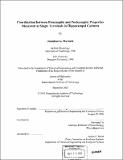Coordination between presynaptic and postsynaptic properties measured at single terminals in hippocampal cultures
Author(s)
Murnick, Jonathan G. (Jonathan George), 1972-
DownloadFull printable version (7.229Mb)
Other Contributors
Massachusetts Institute of Technology. Department of Electrical Engineering and Computer Science.
Advisor
Guosong Liu.
Terms of use
Metadata
Show full item recordAbstract
I examined the spatial scale at which pre-synaptic activity interacts with synaptic strength and developmental events in the post-synaptic cell. I performed this work in primary hippocampal cultures of postnatal Sprague-Dawley rats after 8-10 days in vitro. I measured electrophysiologically the functional addition of GluR2 and NR2A subunits to AMPA and NMDA receptors, respectively, as well as the absolute strength of AMPA- and NMDA-mediated currents. I examined both spontaneous quantal events and local responses using glutamate iontophoresis at putative single-synaptic sites. I monitored pre-synaptic strength via vesicle staining with FM dyes. I found an inverse correlation between pre-synaptic and post-synaptic strength at individual synapses: Intensity of presynaptic FM-staining was inversely correlated with AMPA current magnitude measured by local iontophoretic stimulation. I also found a negative correlation at individual puncta between FM-staining intensity and decay time of iontophoretically-evoked NMDA decay current. Presumably, this correlation reflects a higher proportion of NR2A subunits at presynaptically more active synapses. I propose that homeostatic feedback mechanisms may operate at a subecellular level to maintain excitatory synaptic input at a single synapse or within a dendritic branch. In order to stimulate individual synaptic sites, I used a novel iontophoresis system, presented here. The system incorporates a 0.1 [mu]m electrode tip for local stimulation, combined with fast capacitance compensation to achieve high-speed application from a high-resistance tip. (cont.) Ejection of fluorescent dye from the electrode shows that transmitter can be limited to the width of a single synapse and to a time scale similar to an endogenous event. The speed and localization of transmitter is confirmed by iontophoretically stimulating single labeled synapses in cultured hippocampal neurons held under voltage clamp. The amount of transmitter ejected is linear and reproducible over a physiologically relevant range, making this technique useful for examining receptor kinetics and receptor insertion/removal. The system should be capable of delivering any charged neurotransmitter.
Description
Thesis (Ph. D.)--Massachusetts Institute of Technology, Dept. of Electrical Engineering and Computer Science, 2003. Vita. Includes bibliographical references (p. 68-71).
Date issued
2003Department
Massachusetts Institute of Technology. Department of Electrical Engineering and Computer SciencePublisher
Massachusetts Institute of Technology
Keywords
Electrical Engineering and Computer Science.